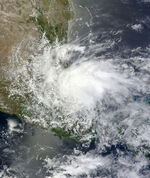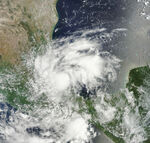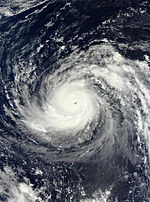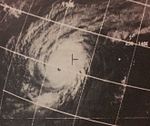The 2100 Pacific hurricane season was the most active Pacific hurricane season on record in terms of named storms. It started on May 15, 2100 for the East Pacific and June 1, 2100 for the Central Pacific, and ended on November 30, 2100 in both basins, dates that conventionally delimit the the period of each year when most tropical cyclones form in the northeastern Pacific Ocean.
Forecasts
| Source | Date | Named storms |
Hurricanes | Major hurricanes | |
| Average (1971–2006) | 15.3 | 8.8 | 4.2 | ||
| Record high activity | 28 | 16 (tie) | 10 | ||
| Record low activity | 8 (tie) | 3 | 0 (tie) | ||
| ––––––––––––––––––––––––––––––––––––––––––––––––––––––– | |||||
| NOAA | May 26, 2100 | 19-25 | 11-15 | 7-10 | |
| ––––––––––––––––––––––––––––––––––––––––––––––––––––––– | |||||
| Actual activity (as of October 1) | 38 | 23 | 16 | ||
On May 26, the Climate Prediction Center released its pre-season outlook. The scientists stated a 15% chance of a below-normal season, a 40% chance of a near-normal season and a 45% chance of an above-normal season. The climatologists expected 19–25 named storms, with 11–15 becoming hurricanes, and 7–10 becoming major hurricanes. The above-normal activity forecast was because despite being in moderate to strong La Niña conditions, wind shear was abnormally low and sea surface temperatures (SST's) were at near record high levels.
Season summary
Timeline of tropical activity in the 2100 Pacific hurricane season

The 2100 Pacific hurricane season, unlike the Atlantic season, didn't start until the end of June due to the moderate La Niña conditions. However, the inactivity abruptly halted on June 27 with the formation of Tropical Depression One-E. The depression became Tropical Storm Andres on June 29, the latest date for a season's first named storm to a Pacific hurricane season since 1969, when the first storm (Tropical Storm Ava) developed on July 1. Despite the late start, Tropical Storms Andres, Blanca, and Carlos all were named in a span of 18 hours, which forecasts called the harbinger to an active season. Following the rapid start, nine named storms developed in July. This was the most active July since the start of the Pacific satellite era in 1971 in terms of named storms (breaking the previous record of seven set in 1985), and it also marked the first time since August 2009 that any month produced nine total storms. With the record active July, 2100 became the first season since 1985 to have 12 tropical storms form before the end of July. The month of August was even more active, with 11 total storms forming, breaking the record of nine set in 1968 and 2009. By the end of August, 23 total storms had formed, well ahead of the previous record of just 16 (set in 1985). Even though the La Niña actually intensified in September, 14 total storms formed, more than double the previous record of six set in 1966 and 2005. As of October 1, the number of storms, hurricanes, and major hurricanes are all at record high levels.
The season's current accumulated cyclone energy (ACE) is 244 (Eastern Pacific - 191, Central Pacific - 53).
Rapid storm formation
Beginning with Hurricane Hilda, every Eastern Pacific forming storm broke the record for the earliest forming nth storm. The following tables provide more in-depth details of this year's exceptionally rapid storm activity:
Eastern Pacific
| Storm # | Formation Day | Name | Previous Record | Difference |
|---|---|---|---|---|
| 1 | June 29 | Andres | Alma , One-E and Aletta - May 14, 1990 , May 14, 1996 and May 14,2012 | +46 days |
| 2 | June 30 | Blanca | Bud - May 22, 2012 | +39 days |
| 3 | June 30 | Carlos | Connie - June 8, 1974 | +22 days |
| 4 | July 4 | Dolores | Dolores - June 14, 1974 | +20 days |
| 5 | July 6 | Enrique | Elida - June 26, 1990 | +10 days |
| 6 | July 11 | Felicia | Fausto - July 3, 1984 | +8 days |
| 7 | July 15 | Guillermo | Genevieve - July 7, 1984 | +8 days |
| 8 | July 17 | Hilda | Hilda - July 19, 1985 | -2 days |
| 9 | July 20 | Ignacio | Ignacio - July 21, 1985 | -1 day |
| 10 | July 20 | Jimena | Jimena - July 21, 1985 | -1 day |
| 11 | July 27 | Kevin | Kevin - July 29, 1985 | -2 days |
| 12 | July 30 | Linda | Linda - July 31, 1985 | -1 day |
| 13 | August 4 | Marty | Marty - August 7, 1985 | -3 days |
| 14 | August 4 | Nora | Nora - August 21, 1985 | -17 days |
| 15 | August 4 | Olaf | Olaf - August 24, 1985 | -20 days |
| 16 | August 12 | Patricia | Pauline - August 31, 1985 | -19 days |
| 17 | August 13 | Rick | Rick - September 2, 1985 | -20 days |
| 18 | August 22 | Sandra | Sandra - September 7, 1985 | -16 days |
| 19 | August 24 | Terry | Terry - September 16, 1985 | -23 days |
| 20 | August 28 | Vivian | Vivian - September 20, 1985 | -23 days |
| 21 | September 3 | Waldo | Winifred - October 7, 1992 | -34 days |
| 22 | September 6 | Xina | Xavier - October 14, 1992 | -38 days |
| 23 | September 10 | York | Yolanda - October 16, 1992 | -36 days |
Central Pacific
| Storm # | Formation Day | Name | Previous Record | Difference |
|---|---|---|---|---|
| 1 | August 8 | Akoni | Ekeka - January 28, 1992 | +192 days |
| 2 | August 15 | Ema | Hali - March 29, 1992 | +139 days |
| 3 | August 18 | Hene | Moke - September 4, 1984 | -17 days |
| 4 | September 4 | Iona | Iwa - November 19, 1982 | -76 days |
List of storms
Tropical Storm Andres
| Tropical storm (SSHWS) | |
| Duration | June 27 – June 30 |
|---|---|
| Peak intensity | 50 mph (85 km/h) (1-min) 998 mbar (hPa) |
Andres was a short-lived tropical storm that did not affect land.
Tropical Storm Blanca
| Tropical storm (SSHWS) | |
| Duration | June 29 – July 3 |
|---|---|
| Peak intensity | 65 mph (105 km/h) (1-min) 996 mbar (hPa) |
Blanca was a strong tropical storm that did not affect land.
Hurricane Carlos
| Category 1 hurricane (SSHWS) | |
| Duration | June 30 – July 6 |
|---|---|
| Peak intensity | 85 mph (140 km/h) (1-min) 988 mbar (hPa) |
Carlos was a minimal hurricane with no land effects.
Hurricane Dolores
| Category 2 hurricane (SSHWS) | |
| Duration | July 3 – July 9 |
|---|---|
| Peak intensity | 100 mph (160 km/h) (1-min) 966 mbar (hPa) |
Dolores was a moderate hurricane with no land effects.
Hurricane Enrique
| Category 5 hurricane (SSHWS) | |
| Duration | July 6 – July 21 |
|---|---|
| Peak intensity | 160 mph (260 km/h) (1-min) 917 mbar (hPa) |
Enrique was tied with Hurricane Felicia later that year as the strongest July cyclone recorded in the East Pacific, surpassing the record set by Gilma in 1994 (it reached 920 millibars (mb)). It made landfall over Coronado, California as a tropical depression on July 30 (the first California landfalling tropical system since Norman in 1978), causing $500 million (2100 USD) dollars in damage, but no deaths.
Hurricane Felicia
| Category 5 hurricane (SSHWS) | |
| Duration | July 11 – August 3 |
|---|---|
| Peak intensity | 160 mph (260 km/h) (1-min) 917 mbar (hPa) |
Felicia was the longest lasting Pacific hurricane since Hurricane Tina in 1992 (until its longevity was exceeded by several other storms that year), and it was tied with Hurricane Enrique earlier that year as the strongest July tropical cyclone. Despite its longevity and strength, Felicia did not affect land.
Hurricane Guillermo
| Category 4 hurricane (SSHWS) | |
| Duration | July 14 – July 29 |
|---|---|
| Peak intensity | 145 mph (230 km/h) (1-min) 946 mbar (hPa) |
Guillermo was a long-lived intense hurricane, but it did not affect land.
Hurricane Hilda
| Category 3 hurricane (SSHWS) | |
| Duration | July 17 – July 26 |
|---|---|
| Peak intensity | 115 mph (185 km/h) (1-min) 951 mbar (hPa) |
Hilda was a powerful hurricane with no land effects.
Tropical Storm Ignacio
| Tropical storm (SSHWS) | |
| Duration | July 20 – July 22 |
|---|---|
| Peak intensity | 60 mph (95 km/h) (1-min) 995 mbar (hPa) |
Ignacio was a short-lived tropical storm that did not affect land.
Tropical Storm Jimena
| Tropical storm (SSHWS) | |
| Duration | July 20 – July 22 |
|---|---|
| Peak intensity | 60 mph (95 km/h) (1-min) 995 mbar (hPa) |
Jimena was a short-lived tropical storm that did not affect land.
Tropical Depression Eleven-E
| Tropical depression (SSHWS) | |
| Duration | July 24 – July 24 |
|---|---|
| Peak intensity | 35 mph (55 km/h) (1-min) 998 mbar (hPa) |
Tropical Depression Eleven-E was a short-lived tropical depression that did not affect land.
Hurricane Kevin
| Category 1 hurricane (SSHWS) | |
| Duration | July 27 – July 29 |
|---|---|
| Peak intensity | 80 mph (130 km/h) (1-min) 991 mbar (hPa) |
Kevin was a minimal hurricane that did not affect land.
Tropical Storm Linda
| Tropical storm (SSHWS) | |
| Duration | July 30 – August 4 |
|---|---|
| Peak intensity | 45 mph (75 km/h) (1-min) 999 mbar (hPa) |
Linda was a tropical storm that made landfall near Puerto Vallartaon August 2 as a tropical storm, causing $100 million (2100 USD), but no deaths.
Tropical Depression Qualia
| Tropical depression (SSHWS) | |
| Duration | July 30 (Entered Basin) – July 31 |
|---|---|
| Peak intensity | 35 mph (55 km/h) (1-min) 998 mbar (hPa) |
The remnants of Atlantic Hurricane Qualia survived over the terrain of Mexico to briefly become a tropical depression, but dissipated before causing any deaths or damage.
Hurricane Marty
| Category 5 hurricane (SSHWS) | |
| Duration | August 3 – August 26 |
|---|---|
| Peak intensity | 165 mph (270 km/h) (1-min) 905 mbar (hPa) |
Marty was a long-lived intense hurricane that brought hurricane force winds (but didn't make a landfall) to San Francisco, California (the first storm to bring hurricane force winds to California since 1858), causing $400 million (2100 USD) dollars in damages, but no deaths. Marty was the strongest August Pacific hurricane on record (beating Hurricane Guillermo in 1997(which had a pressure of 919 mb)) until Patricia and Rick later that year surpassed it.
Tropical Storm Nora
| Tropical storm (SSHWS) | |
| Duration | August 4 – August 6 |
|---|---|
| Peak intensity | 55 mph (90 km/h) (1-min) 994 mbar (hPa) |
Nora was a short-lived tropical storm that made landfall near León, Nicaragua on August 6 as a tropical storm, causing a horrendous $2 billion (2100 USD) dollars in damage, but amazingly, no deaths were reported. A portion of Nora's remnants survived into the North Atlantic, but dissipated before regenerating.
Tropical Storm Olaf
| Tropical storm (SSHWS) | |
| Duration | August 4 – August 6 |
|---|---|
| Peak intensity | 55 mph (90 km/h) (1-min) 994 mbar (hPa) |
Olaf was a short-lived tropical storm that made landfall near Carrillo, Costa Rica as a tropical storm on August 6 (the first Pacific landfalling Costa Rica system on record), causing a staggering $1 billion (2100 USD) dollars in damage, but no deaths were reported. Similar to Nora, a portion of Olaf's remnants survived into the Atlantic but dissipated before regenerating.
Tropical Storm Akoni
| Tropical storm (SSHWS) | |
| Duration | August 6 – August 9 |
|---|---|
| Peak intensity | 70 mph (110 km/h) (1-min) 988 mbar (hPa) |
Akoni was a Central Pacific tropical storm that did not affect land.
Tropical Depression Two-C
| Tropical depression (SSHWS) | |
| Duration | August 8 – August 8 |
|---|---|
| Peak intensity | 30 mph (45 km/h) (1-min) 1004 mbar (hPa) |
Lasting barely 12 hours, Tropical Depression Two-C was the shortest lived tropical cyclone of the season (it didn't affect land).
Hurricane Patricia
| Category 6 hurricane (NHC) | |
| Duration | August 10 – August 29 |
|---|---|
| Peak intensity | 185 mph (295 km/h) (1-min) 902 mbar (hPa) |
Patricia was an extremely intense hurricane, tying with Linda in 1997 as the strongest Pacific tropical cyclone on record (until Rick later that month and then Waldo in September broke the record). Despite its longevity, Patricia did not affect land. When Patricia became a Category 5, it marked the first time four Category 5 hurricanes formed in one single Pacific hurricane season, breaking the record of three set in 1994 and 2002.
Hurricane Rick
| Category 6 hurricane (NHC) | |
| Duration | August 12 – September 7 |
|---|---|
| Peak intensity | 190 mph (305 km/h) (1-min) 898 mbar (hPa) |
Rick was an exceptionally intense and long-lived hurricane, becoming the strongest Pacific hurricane on record, beating Linda in 1997 and Patricia earlier that same year (the two storms had 902 mb pressures) (until it was surpassed by Hurricane Waldo later that year), and the longest-lasting Pacific hurricane on record, beating Hurricane Tina in 1992. Despite its record-breaking intensity, Rick did not affect land.
Hurricane Ema
| Category 1 hurricane (SSHWS) | |
| Duration | August 14 – August 20 |
|---|---|
| Peak intensity | 85 mph (140 km/h) (1-min) 992 mbar (hPa) |
Ema was a minimal hurricane that did not affect land.
Tropical Storm Hene
| Tropical storm (SSHWS) | |
| Duration | August 16 – August 19 |
|---|---|
| Peak intensity | 65 mph (100 km/h) (1-min) 991 mbar (hPa) |
Hene was a short-lived tropical storm that did not affect land.
Hurricane Shary
| Category 5 hurricane (SSHWS) | |
| Duration | August 16 (Entered Basin) – August 22 (Exited Basin) |
|---|---|
| Peak intensity | 160 mph (260 km/h) (1-min) 924 mbar (hPa) |
Atlantic Hurricane Shary crossed into the East Pacific for six days before reentering the Atlantic. It made landfall near Puerto Vallarta, Mexico as a Category 5 hurricane, causing $900 million (2100 USD) dollars in damage, but no deaths occured.
Hurricane Sandra
| Category 3 hurricane (SSHWS) | |
| Duration | August 21 – September 2 |
|---|---|
| Peak intensity | 125 mph (200 km/h) (1-min) 953 mbar (hPa) |
Sandra was a long-lived intense hurricane that did not affect land.
Hurricane Terry
| Category 2 hurricane (SSHWS) | |
| Duration | August 24 – August 30 |
|---|---|
| Peak intensity | 110 mph (175 km/h) (1-min) 966 mbar (hPa) |
Terry was a moderate hurricane with no land effects.
Tropical Storm Vivian
| Tropical storm (SSHWS) | |
| Duration | August 28 – August 30 |
|---|---|
| Peak intensity | 60 mph (95 km/h) (1-min) 997 mbar (hPa) |
Vivian was a short-lived tropical storm that brought minor amounts of percipitation to Baja California Sur.
Hurricane Waldo
| Category 6 hurricane (NHC) | |
| Duration | September 1 – September 20 (Exited Basin) |
|---|---|
| Peak intensity | 195 mph (310 km/h) (1-min) 894 (Pacific record low) mbar (hPa) |
Waldo was a long-lived intense hurricane (the strongest Pacific hurricane on record, breaking Rick's short-lived record) that did not affect land.
Hurricane Iona
| Category 1 hurricane (SSHWS) | |
| Duration | September 4 – September 7 (Crossed into the West Pacific) |
|---|---|
| Peak intensity | 80 mph (130 km/h) (1-min) 991 mbar (hPa) |
Iona was a minimal hurricane that had no land effects.
Hurricane Xina
| Category 3 hurricane (SSHWS) | |
| Duration | September 6 – September 19 |
|---|---|
| Peak intensity | 115 mph (185 km/h) (1-min) 953 mbar (hPa) |
Xina was a long-lived intense hurricane that did not affect land.
Hurricane York
| Category 1 hurricane (SSHWS) | |
| Duration | September 10 – September 17 |
|---|---|
| Peak intensity | 90 mph (150 km/h) (1-min) 986 mbar (hPa) |
York was a minimal hurricane with no land effects.
Hurricane Keli
| Category 5 hurricane (SSHWS) | |
| Duration | September 11 – September 15(Exited Basin) |
|---|---|
| Peak intensity | 160 mph (260 km/h) (1-min) 899 mbar (hPa) |
Hurricane Zelda
| Category 4 hurricane (SSHWS) | |
| Duration | September 12 – October 30 |
|---|---|
| Peak intensity | 155 mph (250 km/h) (1-min) 900 mbar (hPa) |
Hurricane Able
| Category 4 hurricane (SSHWS) | |
| Duration | September 16 – October 10 |
|---|---|
| Peak intensity | 130 mph (215 km/h) (1-min) 911 mbar (hPa) |
Storm names
See also: List of retired Pacific hurricane names
The following names will be used to name storms that form in the Northeastern Pacific Ocean in 2100. Retired names, if any, will be announced by the World Meteorological Organization (WMO) in the spring of 2101. Names that were not assigned are marked in gray, and the names of storms currently active are marked in bold. A storm was named York for the first time in 2100.
NOTE: An Atlantic storm, Hurricane Shary, crossed into the Pacific and kept is Atlantic name and number.
|
|
|
Central Pacific
For the central Pacific Ocean, four consecutive lists are used, with the names used sequentially until exhausted, rather than until the end of the year, due to the low number of storms each year. The next eight names on the list are shown below. Storms were named Hene and Iona for the first time in 2100.
|
|
|
|




































